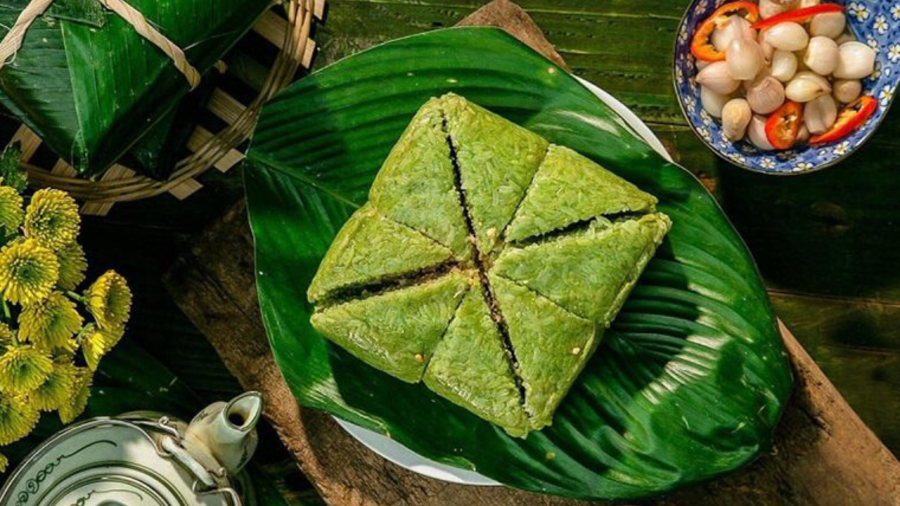The Nutritional Value of Banh Chung
According to the information provided by the Food Safety Department – Ministry of Health, the Tet meal is full of delicious food, but the unique dish of our nation during Tet is still the green Banh Chung.
In terms of nutrition, Banh Chung is a well-rounded dish. Since ancient times, our people have known how to combine different ingredients scientifically to create this traditional ethnic cake with rich flavors.
Inside Banh Chung, there are sufficient amounts of protein, carbohydrates, fats, vitamins, and minerals in appropriate proportions.

According to the Food Safety Department – Ministry of Health, an average-sized Banh Chung consists of 500g of glutinous rice, 100g of mung beans, 100g of fatty pork, and about 5g of fresh onion.
The nutritional composition of this Banh Chung includes 79.55g of protein, 47.20g of fat, 427.84g of carbohydrates, 7.13g of minerals (calcium 0.233g, phosphorus 1.025g, iron 0.016g, etc.), 0.081mg of vitamin A, 1.68mg of vitamin B1, 0.43mg of vitamin B2, 13.21mg of vitamin PP, providing the body with 2,620 Kcal.
Therefore, eating just one Banh Chung a day is enough to meet the nutritional needs of an average worker and is a well-balanced portion in terms of quantity and quality.
According to the National Nutrition Institute, Banh Chung is often eaten with pickled vegetables and salted onions. This is also a traditional and scientifically sound way of eating passed down by our ancestors.
In terms of nutrition, Banh Chung consists of 4 food groups, with ingredients such as glutinous rice (carbohydrates), mung beans, pork (animal and plant protein, fats), onions, and pepper (vitamins and minerals).
Additionally, Banh Chung is made from glutinous rice, which is difficult to digest. Therefore, when eating Banh Chung with pickled vegetables and salted onions, it stimulates digestion and prevents bloating.
100g of Banh Chung provides 181Kcal of energy, 4.3g of protein, 4.2g of fat, 31.6g of carbohydrates, 0.6g of fiber, 26g of calcium, 0.94g of iron, and 1.4g of zinc.
A medium-sized piece of Banh Chung weighs about 114g. A small piece of Banh Chung with mung bean filling usually weighs around 25g and provides 50Kcal of energy, 1.8g of protein, 0.7g of fat, and 9.2g of carbohydrates.
4 Best Tips for Eating Banh Chung
Limit the Consumption of Banh Chung
Nutrition experts recommend limiting the amount of Banh Chung consumed, especially during Tet, to avoid weight gain.
For those who are overweight, obese, or have cardiovascular diseases, diabetes, high blood pressure, it is even more important to limit or avoid it completely.
It is advisable to eat a small piece, equivalent to 1/8 of a medium-sized Banh Chung, for each meal. If you eat Banh Chung, absolutely do not eat rice, sticky rice, or other starchy and protein-rich foods afterwards.

Diversify Food Combinations
Although Banh Chung is a nutritionally well-balanced food, when eating Banh Chung, it is not recommended to eat it alone, as it can cause satiety and is not beneficial for health.
According to Dr. Nguyen Van Tien, Banh Chung is often eaten with pickled vegetables and salted onions. This is also a traditional and scientifically sound way of eating passed down by our ancestors. Banh Chung is made from glutinous rice, which is difficult to digest. Therefore, when eating Banh Chung with pickled vegetables and salted onions, it stimulates digestion and prevents bloating.
When eating Banh Chung, it is recommended to eat fruits and green vegetables to balance the nutritional proportions. These foods are rich in fiber, vitamins, and minerals, which help facilitate the metabolism of carbohydrates and promote better digestion.
Limit the Consumption of Fried Banh Chung
Fried Banh Chung may be delicious, but it is high in fat due to the use of oil for frying. Therefore, it is recommended to limit the consumption of fried Banh Chung as it can lead to the accumulation of excess fat, which is not good for the body.
For those with chronic conditions such as hypertension, dyslipidemia, cardiovascular diseases, and kidney diseases, consuming a lot of fried Banh Chung can cause bloating, indigestion, and rapid weight gain.
Especially for those with gastric problems, it is advisable to avoid eating fried Banh Chung, as it can worsen the condition. Consuming an excessive amount of sticky rice can make the stomach constantly uncomfortable and prone to acid reflux.
Note on Choosing and Storing Banh Chung
With the humid weather of spring in the North, Banh Chung is prone to mold due to its high moisture content and rich nutrition, which creates an ideal environment for mold growth. If you consume moldy Banh Chung, it can pose a potential risk of food poisoning, including the presence of aflatoxin, a toxin found in moldy foods that can cause liver damage and increase the risk of cancer. Therefore, when Banh Chung is moldy, it should be discarded instead of cutting off the moldy part and using the remaining portion.
According to Dr. Nguyen Van Tien, in natural conditions, Banh Chung can last for 5 days. If refrigerated, it can last for 15-20 days. It is best to store Banh Chung in the refrigerator at a temperature of 5-10 degrees Celsius. Cut and consume only the portion needed, and tightly wrap the remaining portion in plastic bags.






























